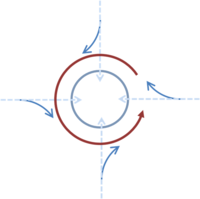imported>John R. Brews |
imported>John R. Brews |
| Line 1: |
Line 1: |
| {{TOC|right}} | | {{TOC|right}} |
| ==Meteorology== | | ==Meteorology== |
| {{Image|Wind deflection.PNG|right|250px|Wind motion in direction of pressure gradient is deflected by the Coriolis force by an amount dependent upon latitude, less closer to the equator and most at the poles.}} | | {{Image|Wind deflection.PNG|left|250px|Wind motion in direction of pressure gradient is deflected by the Coriolis force by an amount dependent upon latitude, less closer to the equator and most at the poles.}} |
| A pressure gradient in the atmosphere is equalized by driving a wind along the pressure gradient. However, from the natural viewpoint of meteorology, the motion is observed in the reference frame of a rotating Earth. As pointed out just above, in the Earth's reference frame, any motion is affected by a Coriolis force, as given by: | | {{Image|Low pressure pattern in northern hemisphere.PNG|right|200px|In the northern hemisphere, Coriolis force deflects winds flowing into a low pressure region to form a counterclockwise flow.}} |
| | A pressure gradient in the atmosphere is equalized by driving a wind along the pressure gradient. However, from the viewpoint of meteorology, the motion is observed most naturally within the reference frame of a rotating Earth. As pointed out just above and in the figure to the left, in the Earth's reference frame any motion is affected by a Coriolis force, as given by: |
|
| |
|
| :<math> \boldsymbol{ v} = \begin{pmatrix} v_e \\ v_n\end{pmatrix}\ ,</math> <math>\boldsymbol{ a_{Cor}} = \begin{pmatrix} v_n \\ -v_e\end{pmatrix}\ f\ , </math> | | :<math> \boldsymbol{ v} = \begin{pmatrix} v_e \\ v_n\end{pmatrix}\ ,</math> <math>\boldsymbol{ a_{Cor}} = \begin{pmatrix} v_n \\ -v_e\end{pmatrix}\ f\ , </math> |
|
| |
|
| where ''f'' = {{nowrap|2''ω'' sin''φ''}} is called the ''Coriolis parameter''. Consequently, the wind takes an apparent direction deflected to the right of the pressure gradient in the northern latitudes, and to the left in the southern latitudes. The Coriolis parameter is a maximum at the poles, zero at the equator and flips sign as one crosses form the northern to southern hemispheres, as indicated in the figure. | | where ''f'' = {{nowrap|2''ω'' sin''φ''}} is the Coriolis parameter. Consequently, the wind takes an apparent direction deflected to the right of the pressure gradient in the northern latitudes, and to the left in the southern latitudes. The Coriolis parameter is a maximum at the poles, zero at the equator and flips sign as one crosses form the northern to southern hemispheres, as indicated in the figure. |
| | |
| | One consequence is that a low pressure region that sucks air into it, as shown in the figure, results in a counterclockwise flow of winds in the northern hemisphere because of the Coriolis force. |
|
| |
|
| ==Notes== | | ==Notes== |
Meteorology

(PD) Image: John R. Brews Wind motion in direction of pressure gradient is deflected by the Coriolis force by an amount dependent upon latitude, less closer to the equator and most at the poles.

(PD) Image: John R. Brews In the northern hemisphere, Coriolis force deflects winds flowing into a low pressure region to form a counterclockwise flow.
A pressure gradient in the atmosphere is equalized by driving a wind along the pressure gradient. However, from the viewpoint of meteorology, the motion is observed most naturally within the reference frame of a rotating Earth. As pointed out just above and in the figure to the left, in the Earth's reference frame any motion is affected by a Coriolis force, as given by:


where f = 2ω sinφ is the Coriolis parameter. Consequently, the wind takes an apparent direction deflected to the right of the pressure gradient in the northern latitudes, and to the left in the southern latitudes. The Coriolis parameter is a maximum at the poles, zero at the equator and flips sign as one crosses form the northern to southern hemispheres, as indicated in the figure.
One consequence is that a low pressure region that sucks air into it, as shown in the figure, results in a counterclockwise flow of winds in the northern hemisphere because of the Coriolis force.
Notes
Contributed by myself in June 2008, for example, here here, added Limerick
http://books.google.com/books?id=-3H5V0LGBOgC&pg=PA122&dq=Foucault+pendulum&hl=en&ei=CV1gTenZOpGisQO9ruzNCA&sa=X&oi=book_result&ct=result&resnum=9&ved=0CGQQ6AEwCA#v=onepage&q=Foucault%20pendulum&f=false
http://books.google.com/books?id=NAo7yv7Jmq0C&pg=PA22&dq=Foucault+pendulum&hl=en&ei=VopgTdmBCoK4sQP6p-ncCA&sa=X&oi=book_result&ct=result&resnum=1&ved=0CCoQ6AEwADgK#v=onepage&q=Foucault%20pendulum&f=false
http://books.google.com/books?id=NAo7yv7Jmq0C&pg=PA22&dq=Foucault+pendulum&hl=en&ei=VYVgTcujHoOusAO0vOXNCA&sa=X&oi=book_result&ct=result&resnum=1&ved=0CCoQ6AEwADgK#v=onepage&q=Foucault%20pendulum&f=false
http://books.google.com/books?id=hrBe52GPHrYC&pg=PA351&dq=Foucault+pendulum&hl=en&ei=VYVgTcujHoOusAO0vOXNCA&sa=X&oi=book_result&ct=result&resnum=9&ved=0CFQQ6AEwCDgK#v=onepage&q=Foucault%20pendulum&f=false
http://books.google.com/books?id=GfCil84YTm4C&pg=PA116&dq=Foucault+pendulum&hl=en&ei=E4ZgTeaDGIa-sQP1zvDHCA&sa=X&oi=book_result&ct=result&resnum=8&ved=0CE0Q6AEwBzgU#v=onepage&q=Foucault%20pendulum&f=false
http://books.google.com/books?id=mms6MXH9CuoC&pg=PA22&dq=Foucault+pendulum&hl=en&ei=34ZgTeukEIuesQPMvPHYCA&sa=X&oi=book_result&ct=result&resnum=2&ved=0CCsQ6AEwATge#v=onepage&q=Foucault%20pendulum&f=false
http://books.google.com/books?id=imrm2aOs9_8C&pg=PA90&dq=Foucault+pendulum&hl=en&ei=34ZgTeukEIuesQPMvPHYCA&sa=X&oi=book_result&ct=result&resnum=7&ved=0CEQQ6AEwBjge#v=onepage&q=Foucault%20pendulum&f=false
Maxwell
http://books.google.com/books?id=wr2QOBqOBakC&pg=PA184&dq=Foucault+pendulum&hl=en&ei=U4hgTd-9Foa6sQP3lt3ACA&sa=X&oi=book_result&ct=result&resnum=2&ved=0CDAQ6AEwATgy#v=onepage&q=Foucault%20pendulum&f=false
Practical matters
http://books.google.com/books?id=sSPLspTUYEEC&pg=PA73&dq=Foucault+pendulum&hl=en&ei=U4hgTd-9Foa6sQP3lt3ACA&sa=X&oi=book_result&ct=result&resnum=4&ved=0CDsQ6AEwAzgy#v=onepage&q=Foucault%20pendulum&f=false
http://books.google.com/books?id=1J2hzvX2Xh8C&pg=PA272&dq=Foucault+pendulum&hl=en&ei=D4lgTdrSGIi6sQPrsunYCA&sa=X&oi=book_result&ct=result&resnum=3&ved=0CDIQ6AEwAjg8#v=onepage&q=Foucault%20pendulum&f=false
References



